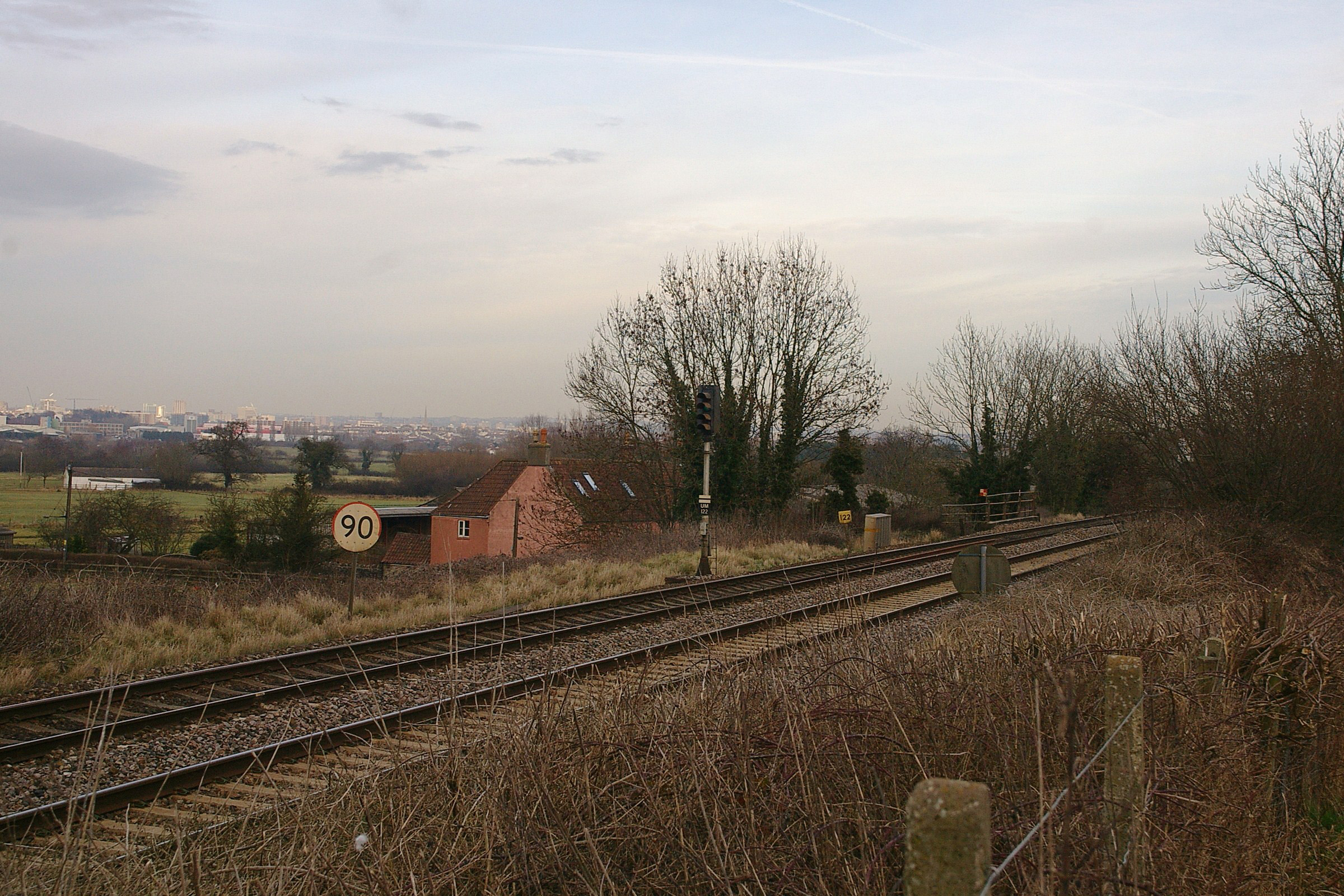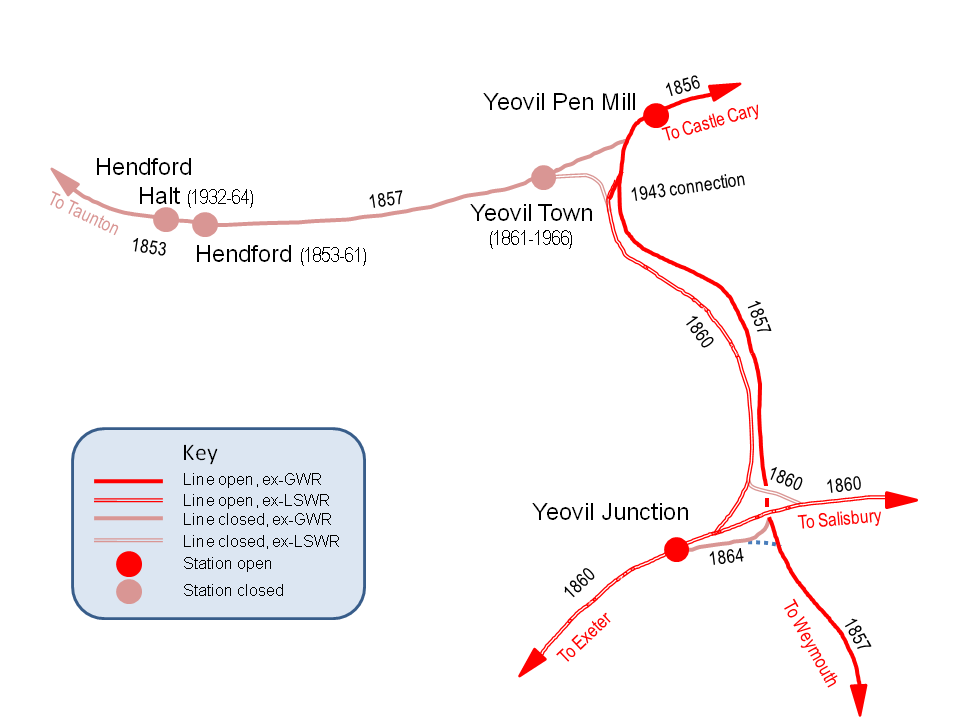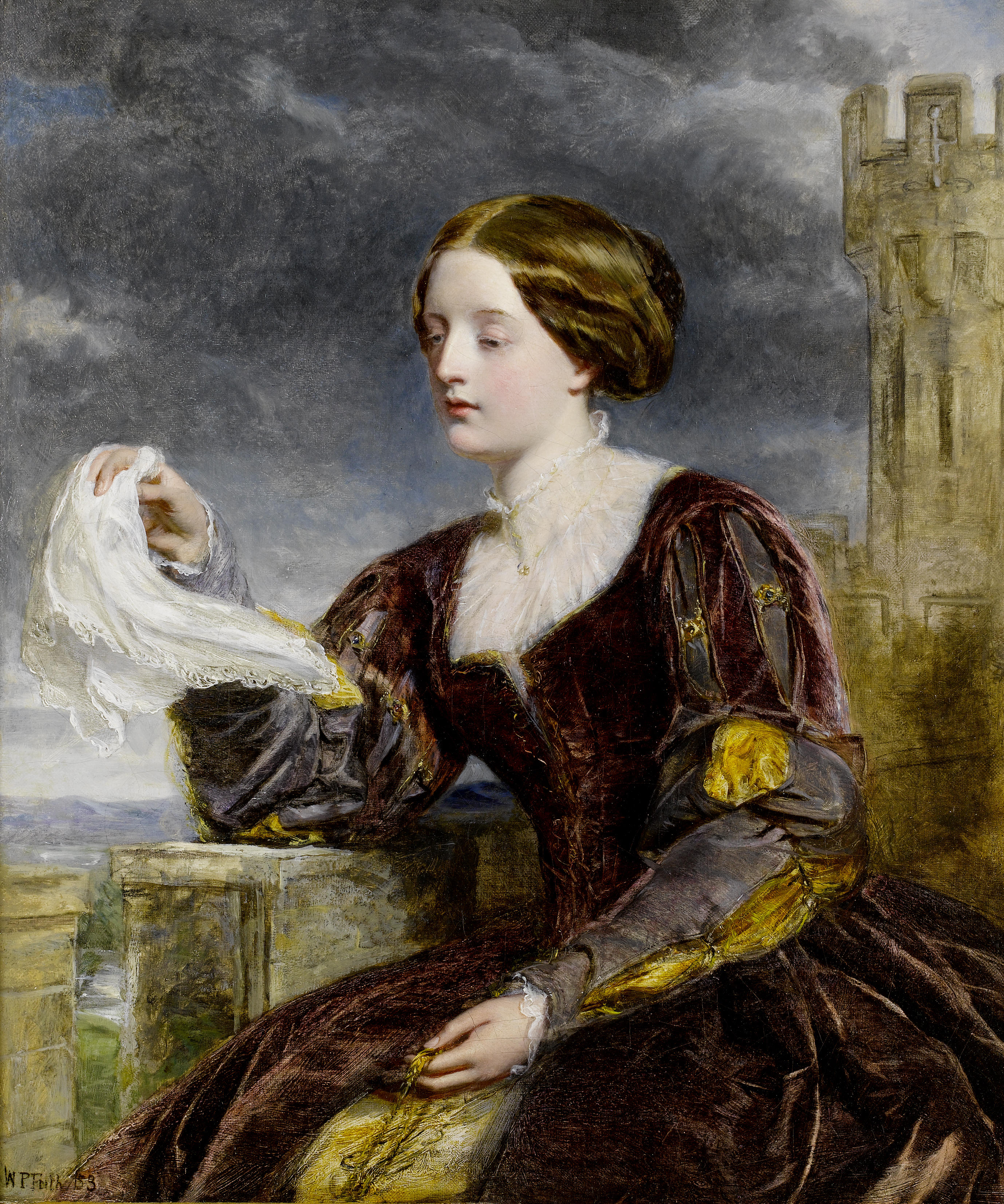|
Cogload Junction
Cogload Junction is a railway junction in Durston, Somerset, England. It is where the 1906-opened London to Penzance Line via Castle Cary joins the original line that runs via Bristol Temple Meads. A flyover was constructed in 1931 converting it into a flying junction. Location The junction is situated in the parish of Durston, east of Taunton railway station, but is named after Cogload Farm which is south of the Castle Cary Line near the junction. It lies alongside the Bridgwater and Taunton Canal. History The Bristol and Exeter Railway was opened through on 1 July 1842. By 1867 it was carrying through trains from London Paddington to , and in 1876 the line became part of the Great Western Railway. On 11 June 1906 goods trains started to run over the new Langport and Castle Cary Railway line between Cogload and , and passenger trains joined them on 2 July that year. This shortened the journey from London to Taunton (and Penzance) by . At this time an ordinar ... [...More Info...] [...Related Items...] OR: [Wikipedia] [Google] [Baidu] |
Durston
Durston is a village and civil parish in Somerset, England, situated on the A361 road north east of Taunton and south of Bridgwater in the Somerset West and Taunton district. The parish lies on undulating ground between the lowest slopes of the Quantock Hills and the valley of the River Tone at the Curry and Hay Moors. The parish has a population of 136. History The place-name derives from the Anglo-Saxon word 'deór-tún', being a combination of the word for a wild animal, a deer (deór,) and the word for a fenced enclosure (tún). The most likely interpretation is 'deer park’. Alwig (a Saxon; also written Alwi) held DURSTON manor from King Edward the Confessor before the Norman Conquest. Durston appeared in the Domesday Book in 1086 as follows: ''Richard holds of Roger Arundel, DURSTON. Alwig held it TRE and it paid geld for 2 hides and 3 virgates of land. There is land for 4 ploughs. In demesne is 1 plough and 4 slaves; and 4 villans and 5 bordars and 4 cottars with 3 ... [...More Info...] [...Related Items...] OR: [Wikipedia] [Google] [Baidu] |
Bristol And Exeter Railway
The Bristol & Exeter Railway (B&ER) was an English railway company formed to connect Bristol and Exeter. It was built on the broad gauge and its engineer was Isambard Kingdom Brunel. It opened in stages between 1841 and 1844. It was allied with the Great Western Railway (GWR), which built its main line between London and Bristol, and in time formed part of a through route between London and Cornwall. It became involved in the gauge wars, a protracted and expensive attempt to secure territory against rival companies supported by the London and South Western Railway (LSWR) which used the narrow gauge, later referred to as ''standard gauge''. At first it contracted with the GWR for that company to work the line, avoiding the expense of acquiring locomotives, but after that arrangement expired in 1849, the B&ER operated its own line. It opened a number of branches within the general area it served: to Clevedon, Cheddar, Wells, Weston-super-Mare, Chard, Yeovil and Tiverton. The B&E ... [...More Info...] [...Related Items...] OR: [Wikipedia] [Google] [Baidu] |
Truss Bridge
A truss bridge is a bridge whose load-bearing superstructure is composed of a truss, a structure of connected elements, usually forming triangular units. The connected elements (typically straight) may be stressed from tension, compression, or sometimes both in response to dynamic loads. The basic types of truss bridges shown in this article have simple designs which could be easily analyzed by 19th and early 20th-century engineers. A truss bridge is economical to construct because it uses materials efficiently. Design The nature of a truss allows the analysis of its structure using a few assumptions and the application of Newton's laws of motion according to the branch of physics known as statics. For purposes of analysis, trusses are assumed to be pin jointed where the straight components meet, meaning that taken alone, every joint on the structure is functionally considered to be a flexible joint as opposed to a rigid joint with strength to maintain its own shape, and ... [...More Info...] [...Related Items...] OR: [Wikipedia] [Google] [Baidu] |
Durston Railway Station
There are 22 disused railway stations in the between and , 12 of which have structures that can still be seen from passing trains. Most were closed in the 1960s but four of them, especially around , were replaced by stations on new sites. 13 stations remain open on the line today, but there have been proposals to reopen stations at Cullompton and Wellington. Background The route was opened by the Bristol and Exeter Railway in stages between 1841 and 1844. In 1876 this company was amalgamated with the Great Western Railway which, in turn, was nationalised into British Railways in 1948. It is now owned by Network Rail. Apart from the temporary station at Beam Bridge which was only used for a year, the earliest closures were in the Weston-super-Mare area in order to provide new facilities for the traffic to that town, which was much greater than predicted when the line was planned. The majority of the remaining closures followed Dr Beeching's '' Reshaping of British Railways'' ... [...More Info...] [...Related Items...] OR: [Wikipedia] [Google] [Baidu] |
Exeter Panel Signal Box
Exeter () is a city in Devon, South West England. It is situated on the River Exe, approximately northeast of Plymouth and southwest of Bristol. In Roman Britain, Exeter was established as the base of Legio II Augusta under the personal command of Vespasian. Exeter became a religious centre in the Middle Ages. Exeter Cathedral, founded in the mid 11th century, became Anglican in the 16th-century English Reformation. Exeter became an affluent centre for the wool trade, although by the First World War the city was in decline. After the Second World War, much of the city centre was rebuilt and is now a centre for education, business and tourism in Devon and Cornwall. It is home to two of the constituent campuses of the University of Exeter: Streatham and St Luke's. The administrative area of Exeter has the status of a non-metropolitan district under the administration of the County Council. It is the county town of Devon and home to the headquarters of Devon County Council. ... [...More Info...] [...Related Items...] OR: [Wikipedia] [Google] [Baidu] |
Yeovil Branch Line
Yeovil ( ) is a town and civil parish in the district of South Somerset, England. The population of Yeovil at the last census (2011) was 45,784. More recent estimates show a population of 48,564. It is close to Somerset's southern border with Dorset, from London, south of Bristol, from Sherborne and from Taunton. The aircraft and defence industries which developed in the 20th century made it a target for bombing in the Second World War; they are still major employers. Yeovil Country Park, which includes Ninesprings, is one of several open spaces with educational, cultural and sporting facilities. Religious sites include the 14th-century Church of St John the Baptist. The town is on the A30 and A37 roads and has two railway stations. History Archaeological surveys have yielded Palaeolithic burial and settlement sites mainly to the south of the modern town, particularly in Hendford, where a Bronze Age golden torc (twisted collar) was found. Yeovil is on the main Roman ro ... [...More Info...] [...Related Items...] OR: [Wikipedia] [Google] [Baidu] |
Signal Box
In signal processing, a signal is a function that conveys information about a phenomenon. Any quantity that can vary over space or time can be used as a signal to share messages between observers. The '' IEEE Transactions on Signal Processing'' includes audio, video, speech, image, sonar, and radar as examples of signal. A signal may also be defined as observable change in a quantity over space or time (a time series), even if it does not carry information. In nature, signals can be actions done by an organism to alert other organisms, ranging from the release of plant chemicals to warn nearby plants of a predator, to sounds or motions made by animals to alert other animals of food. Signaling occurs in all organisms even at cellular levels, with cell signaling. Signaling theory, in evolutionary biology, proposes that a substantial driver for evolution is the ability of animals to communicate with each other by developing ways of signaling. In human engineering, signal ... [...More Info...] [...Related Items...] OR: [Wikipedia] [Google] [Baidu] |
Langport And Castle Cary Railway
The Langport and Castle Cary Railway is a railway line from Castle Cary railway station to Cogload Junction near Taunton, Somerset, England, which reduced the length of the journey from London to Penzance by . History Through trains from London Paddington station to Penzance in Cornwall started running in 1867 taking a circuitous route over the Great Western Railway (GWR) to Bristol, then the Bristol and Exeter Railway through Taunton to Exeter, the South Devon Railway to Plymouth Millbay railway station, the Cornwall Railway to Truro, and finally completing their journey on the West Cornwall Railway. By 1889 the whole route was controlled by the GWR, but trains still had to take the "Great Way Round" through Bristol. There had been several schemes to build a shorter route to Cornwall, such as the Exeter Great Western Railway, but these came to nothing. Finally in 1895 the GWR directors announced that new lines were to be constructed to enable trains to reach Exeter, Plymou ... [...More Info...] [...Related Items...] OR: [Wikipedia] [Google] [Baidu] |
London Paddington Station
Paddington, also known as London Paddington, is a London station group, Central London railway terminus and London Underground station complex, located on Praed Street in the Paddington area. The site has been the London terminus of services provided by the Great Western Railway and its successors since 1838. Much of the main line station dates from 1854 and was designed by Isambard Kingdom Brunel. Paddington is the London terminus of the Great Western Main Line; passenger services are primarily operated by Great Western Railway (train operating company), Great Western Railway, which provides the majority of commuter and regional passenger services to west London and the Thames Valley region as well as long-distance intercity services to South West England and South Wales. The station is also the eastern terminus for Heathrow Express and the western terminus for Elizabeth line services from Shenfield railway station, Shenfield. Elizabeth line services also run through Paddington ... [...More Info...] [...Related Items...] OR: [Wikipedia] [Google] [Baidu] |
Great Western Railway
The Great Western Railway (GWR) was a British railway company that linked London London is the capital and List of urban areas in the United Kingdom, largest city of England and the United Kingdom, with a population of just under 9 million. It stands on the River Thames in south-east England at the head of a estuary dow ... with the southwest, west and West Midlands (region), West Midlands of England and most of Wales. It was founded in 1833, received its enabling Act of Parliament on 31 August 1835 and ran its first trains in 1838 with the initial route completed between London and Bristol in 1841. It was engineered by Isambard Kingdom Brunel, who chose a broad gauge of —later slightly widened to —but, from 1854, a series of Consolidation (business), amalgamations saw it also operate Standard gauge, standard-gauge trains; the last broad-gauge services were operated in 1892. The GWR was the only company to keep its identity through the Railways Act 1921, which ama ... [...More Info...] [...Related Items...] OR: [Wikipedia] [Google] [Baidu] |








